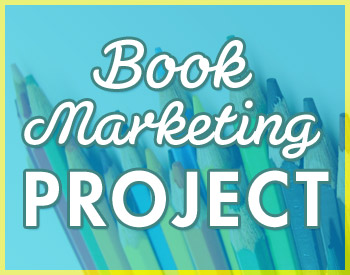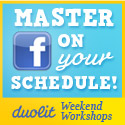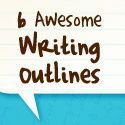 Imagine you’re back in grade school, sitting at your desk and coloring away happily (those were the days, right?)
Imagine you’re back in grade school, sitting at your desk and coloring away happily (those were the days, right?)
Try to remember: Did you prefer starting with a blank sheet of paper or a coloring book page?
I don’t know about you, but I was always more comfortable with that coloring book page — I liked having some idea of where to start creatively filling in the picture!
The roadmap for promoting your book feels much like that blank sheet of paper. Even with a guide like the Weekend Book Marketing Makeover in hand, it can be hard to either 1) sit down and complete the exercises as planned or 2) figure out where to go after you finish.
Shannon and I hate to see our author friends floundering in either one of those scenarios, so we’ve come up with a way to help — our new blog series of Book Marketing Projects. Here’s how they’ll work:
Our New Book Marketing Projects
Each month, we’ll give you a project, one concrete thing you can do to move forward your book marketing goals and build your fanbase. We’ll share all the steps and resources you need along the way, so all you have to do is fill in the blanks (and actually do the work).
Plus, the projects themselves won’t take more than a few hours to complete, so you can knock it out in a day or spread the project throughout the month — whatever works for your schedule.
All that we ask in return is that you share a link to your finished product and a bit about your experience along the way in the comments below. Sounds like a good tradeoff, right?
Let’s get started!
This month, we’re going to help you write an introduction email that your readers will automatically receive when signing up for your mailing list and then create a signup incentive to encourage folks to hop aboard.
Prerequisites
To successfully complete this project, you’ll need:
- A mailing list. If you don’t have one, we suggest signing up with Mailchimp. The free plan should suit your needs perfectly! If you’d like some help with the signup process, we walk you through in Lecture 3 of Mailing List Magic, which you can view for free here)
- A website. To host your mailing list freebie (although this is technically optional, since Mailchimp now supports uploads.)
Part 1: Creating Your Mailing List Freebie
Call it what you will (bribe, signup incentive or free gift are also common names), the mailing list freebie rewards your reader for sharing their email address and joining your mailing list. It shows that you value the personal information they’re handing over and starts off your relationship on a good note.
The incentive itself doesn’t have to be long or complicated (woot!), and shouldn’t take you more than an afternoon to create. Be sure to refer to the checklist below when brainstorming ideas!
Mailing List Freebie Checklist
Length. The freebie should be something a reader can easily consume in no more than a few hours. We want to easily capture their attention and reward them for their time. For this reason, we don’t recommend giving away an entire book as a signup incentive.
Content. The makeup of your freebie depends greatly upon your genre, writing style and personal taste but some options that generally work well are:
- A free chapter
- A short story
- An unreleased chapter
- A scene/chapter from another character’s point-of-view
- Audiobook chapter
- Exclusive artwork or extras
But don’t feel like you have to stick to this list — get creative and think outisde the box to come up with unique ideas your readers will love.
Next Step. At the end of your freebie, include a link or prompt for a next step the reader can take. Do you want them to purchase the full book? Send you feedback? Leave a comment or review?
Upload The File
Once you’ve finished your freebie, you’ll need to upload it to your website. This way we can include the link to the file in your introduction email (which we’ll work on next).
Note: If you’re concerned about folks who haven’t signed up for your mailing list finding your freebie: don’t worry. Just because you add a file to your website doesn’t mean that it’s easily accessible to the world at large. 99% of the folks who see your freebie *will* be those who signed up to your mailing list!
Here’s how to upload your file:
- If you have WordPress, you’ll need to upload the file and copy the URL that WordPress creates for the file. I couldn’t find a good tutorial for this on the web, so I created a quick video walking you through the process if you’ve never done it before.
- If you don’t have WordPress, you’ll need to upload the file via FTP on your own (or send it to your web designer to handle it for you)!
- Note: It now appears that Mailchimp allows you to upload files directly to their servers, too. Here’s the instructions on doing that, but note that I haven’t tried it myself.
After uploading the file, be sure to write down the link/URL (on a sticky note or email it to yourself), so you can easily access it in the next part of the project.
Part 2: Writing Your Introduction Email
A good first impression is everything, right?
Put your best face forward to your newly-joined readers by creating a welcoming first email, which will be sent to every new subscriber to your mailing list automatically. I recommend writing the email in Word and then adding it to Mailchimp afterward (it’s the form named Final “Welcome” Email), but it’s up to you. Here’s what to include:
Your Introduction Email Checklist
Welcome. We’re big fans of writing emails to your readers in letter-style, just like writing an email to a friend. In that vein, open your email with a typical greeting (“Hi there!” or “Hello!”) and immediately welcome the reader to your mailing list (“Thanks for joining my mailing list!”).
Trust. It takes a level of trust to hand over your email address these days (your inbox can turn into Spam City, you know?), so be sure to ease your reader’s mind (“With all the spam swirling around the web nowadays, it means a lot that you’d share your email address with me. No worries, your information will never be shared and you won’t receive a drop of spam from me!”)
Frequency. Set expectations up front so your reader knows exactly how often you’ll email them. (“I usually send out emails just once or twice a month — but if I have a launch coming up they might come a bit more frequently. There’s so much exciting stuff to share!”)
Content. What types of email updates will you send out? Give your readers some idea of what they’ll receive in their inbox. (“I’ll send out exclusive news and updates my projects, but also book reviews, personal updates and occasional giveaways.”)
Question. This is your best chance to start a conversation with your readers. Invite them to reply to your welcome email and answer a simple question, like:
- What city are you writing from?
- What’s your favorite book of all time?
- What should I put on my fall reading list?
Link. Don’t forget to add the link to your freebie! (“As a thank you for joining my list, check out an exclusive excerpt from my upcoming novel here!”)
Note: Remember, once you’ve written your email, copy the text to your Final “Welcome” Email in Mailchimp, under Lists > Signup Forms > General Forms > Select Final “Welcome” Email from the dropdown.
The 4-Week Project Schedule
On average, this project should take you about 4-6 hours to complete. Here’s how we recommend breaking it up:
- Week 1 (ending 9/8): Decide on what you’ll use as a signup incentive and outline what you’ll do to create it.
- Week 2 (ending 9/14): Create your signup incentive and upload it to your website.
- Week 3 (ending 9/21): Start writing your introduction email.
- Week 4 (ending 9/28): Finish writing your introduction email and add it to MailChimp.
Share Your Progress
Will you join us in September’s Book Marketing Project? What did you use for your signup incentive? Which question did you ask in your welcome email? Did you run into any snags along the way? Share your experience in the comments!
 We're
We're 








